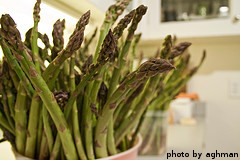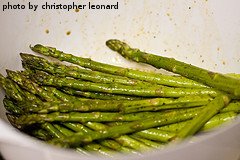Commonly Grown Asparagus Varieties
Asparagus varieties can be classified into three categories:
- Green Apsaragus
- White Asparagus
- Purple Asparagus

Green Aparagus is probably the most common asparagus category in the United States. The spears range from very thin to very thick. A common green variety is the Jersey King, which we grow in our own garden. It has medium diameter spears that average around 7-8 inches long. We like the flavor of this variety, along with how productive it is. Another variety is the Jersey Knight, which boasts long, thin spears reaching 8-10 inches. The Jersey Giant variety features shorter spears that are very thick in diameter. Mary Washington and Martha Washington are also popular varieties, featuring medium-sized spears. They are known to be fast growing and high yielding. Precoce D'Argenteuil is a rarer Italian variety that features thin stalks and rose-colored buds. To our knowledge, this variety is only available in the USA from seed. Millennium is a relatively new variety that was bred in Ontario, Canada. It is typically slower to get going, but demonstrates superior yields after 5 years compared to the "Jersey" and "Washington" varieties. If you know you're going to be enjoying the fruits of your asparagus patch for decades to come, Millenium might be worth considering just because of the increased productivity over the long term.
White Asparagus is the asparagus category most preferred in Europe. The spears are deprived of light by keeping dirt mounded around the plant. Without light, the plants cannot produce chlorophyll, and therefore remain white in color. Any variety of asparagus will produce white spears, as long as it is not exposed to light.
Purple Asparagus is the category that is most commonly found in England and Italy. Purple asparagus produces thick, purple spears that are generally sweeter and more tender than varieties of green asparagus. However, the plants produce less numbers of spears. Purple Passion is the most common variety. Purple asparagus spears usually lose their color when cooked for very long. Some people prefer to eat purple asparagus raw or in salads so that it retains its unique color.
Some people grow several different varieties of asparagus, either intentionally, or because they've added different crowns to their asparagus patch over the years. Either way, different varieties can be used to please the eye and the palate. In addition, different varieties will mature at different times. So, if you really love asparagus, you can keep a continuous supply coming during the harvest period by planting a couple of different varieties. And don't forget, male plants are always preferred over female plants in the garden. This is because male plants typically produce more stalks that are smaller and more tender. Female plants tend to produce larger, tougher stalks, and they spend a great deal of energy producing seeds. Once an asparagus plant goes to seed, stalk production almost stops altogether.
When it comes to choosing which variety of asparagus is right for you, consider a couple of things. First, ask you neighbors if they grow any asparagus or know anyone in the area who grows asparagus. They can point you in the right direction for which variety might grow best in your specific geographic area. For whatever reasons, some asparagus varieties just grow better than others in certain locales. Second, ask around at your local garden centers and plant nurseries which varieties are available. When it comes to asparagus crowns of differing varieties, the ones available at your local garden centers are probably the best option for your specific area. Yes, you can certainly order asparagus seeds and crowns online, but you won't really know if they will be well suited to your specific area until you have quite a bit of time and a little bit of money invested in them. Conversely, if you buy your asparagus crowns locally, you'll have a better idea that they should grow well in your area.
If you have a friend or neighbor that already has an established asparagus patch, you can ask them if they wouldn't mind letting you divide up some of the crowns to plant in your own garden. This activity usually takes place in the winter when the plants are dormant. Just carefully dig up a crown and use a sharp shovel to cut the crowns in half. Replant one of the halves in the same spot and plant the other half in your own garden. If your friend or neighbor doesn't know the exact asparagus variety they are growing, it doesn't really matter, as long as you like it and it grows well in your area.

Click here to learn about planting asparagus
Click here for information about watering and fertilizing asparagus plants
Click here to learn about harvesting asparagus
Click here for asparagus recipe ideas
Click here to move from our Asparagus Varieties page back to the main Growing Asparagus page
Click here to return to our Home page